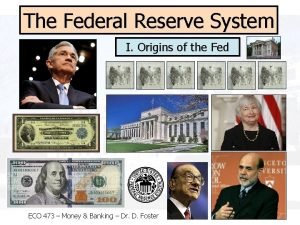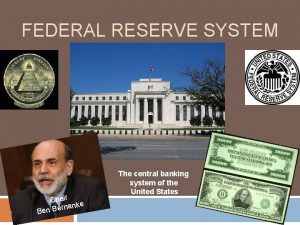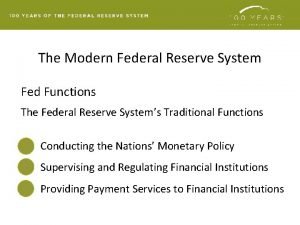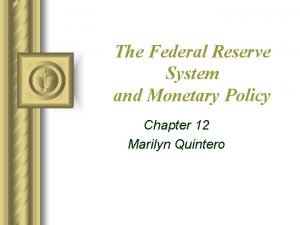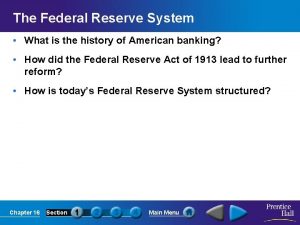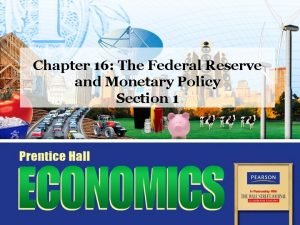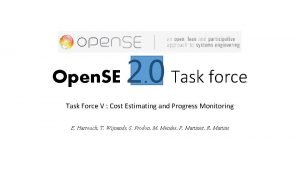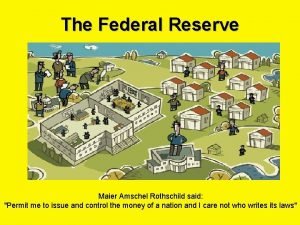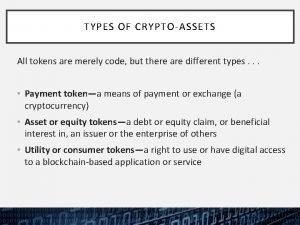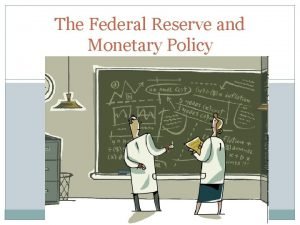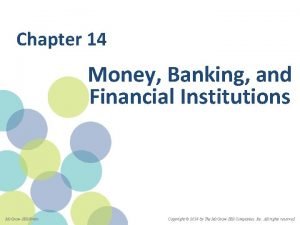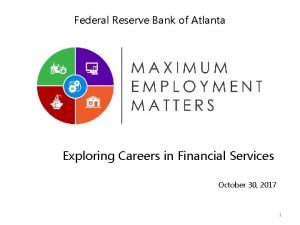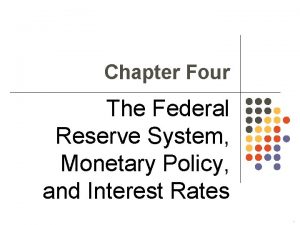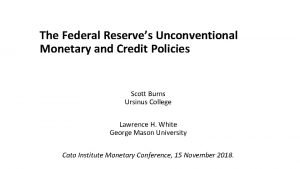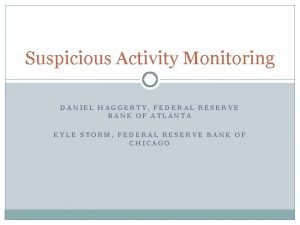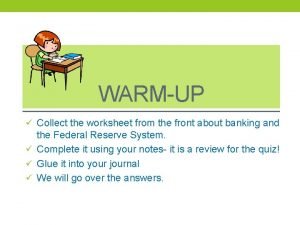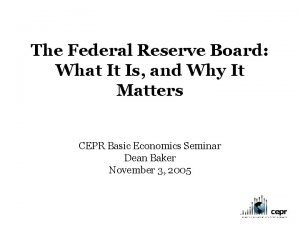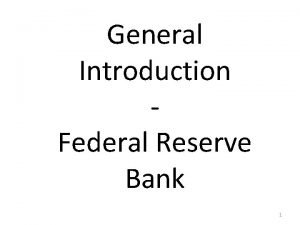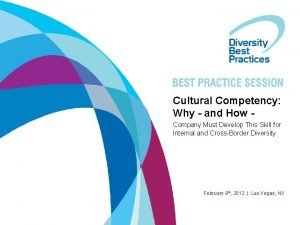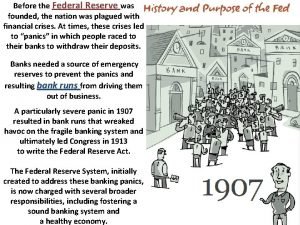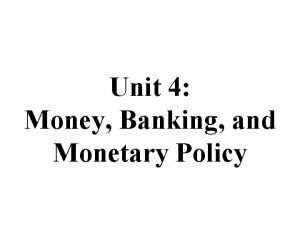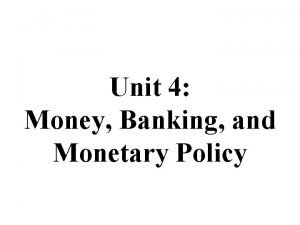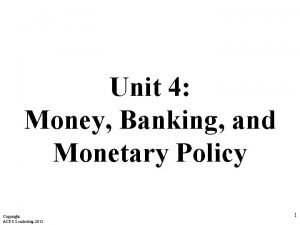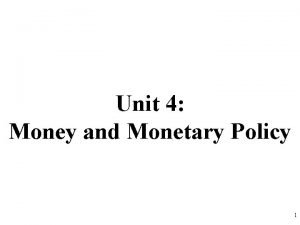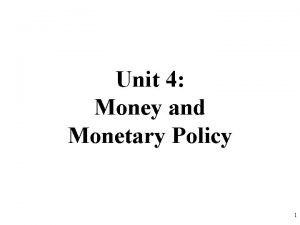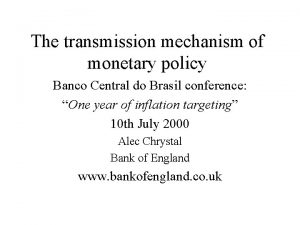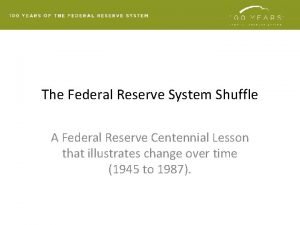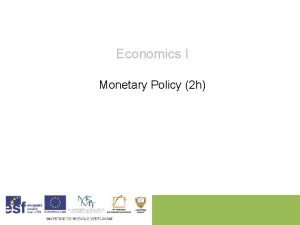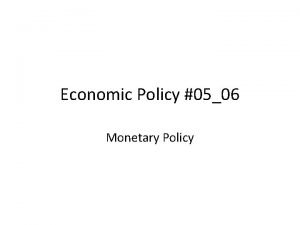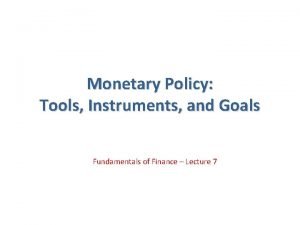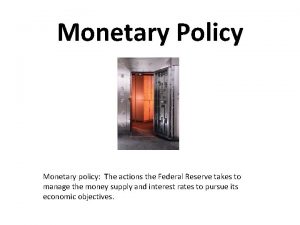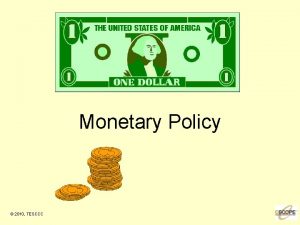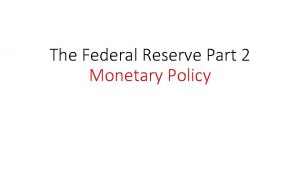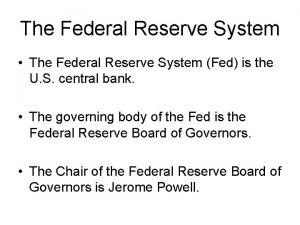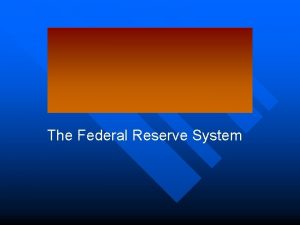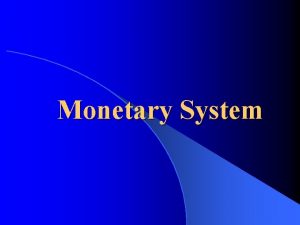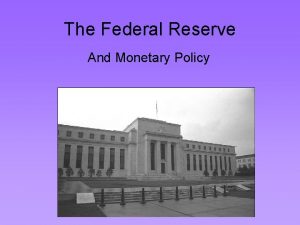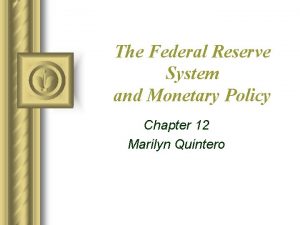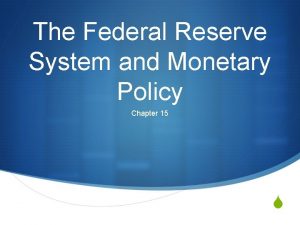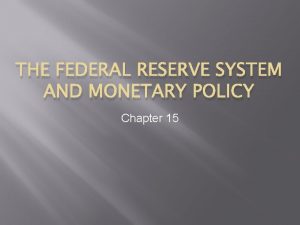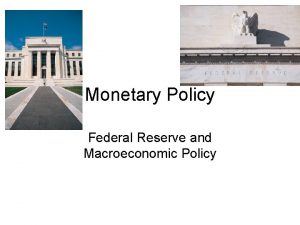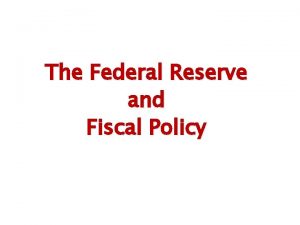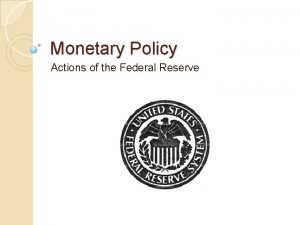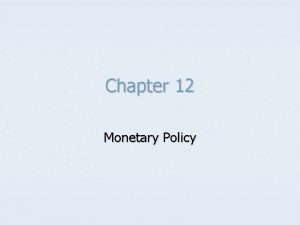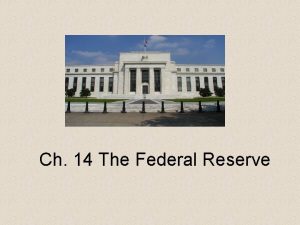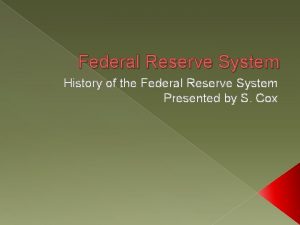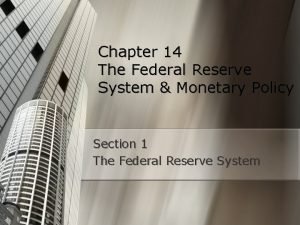The Federal Reserve System and Monetary Policy Chapter












































- Slides: 44

The Federal Reserve System and Monetary Policy Chapter 12 Marilyn Quintero

A Glimpse at History (continued) l The first real U. S. money was the Continental Note. l Since Congress had no taxing authority, it printed Continental Notes to finance the Revolution. l Excessive printing rendered the Continental Note nearly useless.

A Glimpse at History (continued) Nationally-chartered bank l A commercial bank that receives its charter from the comptroller of the currency and is subject to federal law as well as the laws of the state in which it operates.

A Glimpse at History (continued) In colonial times, before banks printed their own bank notes, our money was simply a collection of foreign currencies.

A Glimpse at History (continued) l Alexander Hamilton was born on January 11, 1755 he was a American politician , statesman, writer, lawyer, and soldier. He established the first bank of the United States. l Hamilton is considered the "patronsaint" of the economic philosophy school l Alexander Hamilton proposed a nationally-chartered central bank that would exercise control over the money supply and extend credit to the federal government.

A Glimpse at History (continued) l Congress accepted Hamilton’s plan and created the First Bank of the United States in 1791. l This central bank dampened the inclination of state-chartered banks to over issue notes by demanding that the notes be redeemed in silver and gold.

A Glimpse at History (continued) Nationally-chartered bank l A commercial bank that receives its charter from the comptroller of the currency and is subject to federal law as well as the laws of the state in which it operates.

A Glimpse at History (continued) When the 20 -year charter of the First Bank of the U. S. expired in 1811, advocates of states’ rights in Congress prevailed, and the charter was not renewed.

A Glimpse at History (continued) In 1816 Congress created the Second Bank of the U. S. , which again stabilized state banking practices. As with the First Bank, however, political pressure led to the failure of Second Bank of the U. S. in the 1830 s.

A Glimpse at History (continued) During the Civil War, Congress passed the National Bank Act, which created a national banking system and the office of the comptroller of the currency, which chartered national banks.

A Glimpse at History (continued) National banks had to buy Treasury Bonds equal to one-third of their capital, and could issue notes only in proportion to their Treasury bond holdings.

A Glimpse at History (continued) In 1907 the highly respected Knickerbockers Trust Company collapsed. This spurred a run on banks, a credit crisis, and a recession. Congress responded with the Federal Reserve Act of 1913.

The Federal Reserve System The Federal Reserve Act of 1913 created the Federal Reserve System (the “Fed”). The Fed has 12 regional district banks that serve as the region’s central bank.

The three parts of the Federal Reserve: l Board Of Governors l Reserve Banks l Federal Open Market Committee (FOMC)

Congress gave the Fed AUTONOMY l Could operate without political pressure l No influential/ guidance from federal, state, or local government

Federal Reserve Banks Districts l l l Boston-1 New York-2 Philadelphia-3 Cleveland-4 Richmond-5 Atlanta-6 Chicago-7 (Voting president- Michael Moscow) St. Louis-8 Minneapolis-9 Kansas City-10 Dallas-11 San Francisco-12

THE GEOGRAPHY OF THE FEDERAL RESERVE SYSTEM

IDENTIFYING LETTERS AND DISTRICT BANKS

Exhibit 5: Identifying Letters and District Banks If you look at the seal to the left of George Washington’s picture on a $1 bill and see the letter “G”, in what district bank was that $1 bill issued? • Chicago

ORGANIZATIONAL STRUCTURE OF THE FEDERAL RESERVE SYSTEM

Board of Governors l Located in Washington D. C. l There are seven members (Governors) - Appointed by president, and confirmed by the senate - Governors term is for 14 years - Chairman and vice-chairman serve a term about four years appointed by president

The Federal Reserve System The Fed’s main charge is to safeguard the proper functioning of our monetary system (money supply, interest rates, and the economy’s price level).

The Federal Reserve System Federal Open Market Committee l The Fed’s principal decision-making body, charged with executing the Fed’s open market operations. Discount rate l The interest rate the Fed charges banks that borrow reserves from it.

BANK TRANSACTIONS TRIGGERED BY BRIAN’S PURCHASE

Bank Transactions Triggered by Brian’s Purchase Why does Brian’s check go to the Atlanta Fed and the Cleveland Fed? l One of the functions of a district Fed is to clear checks.

FROM CHANGES IN THE MONEY SUPPLY TO CHANGES IN REAL GDP

FROM CHANGES IN THE MONEY SUPPLY TO CHANGES IN REAL GDP

FROM CHANGES IN THE MONEY SUPPLY TO CHANGES IN REAL GDP

Controlling the Money Supply Countercyclical monetary policy l Policy directives used by the Fed to moderate swings in the business cycle. Reserve requirement l The minimum amount of reserves the Fed requires a bank to hold, based on a percentage of the bank’s total deposit liabilities.

Controlling the Money Supply Federal funds market l The market in which banks lend and borrow reserves from each other for very short periods of time, usually overnight. Federal funds rate l The interest rate on loans made by banks in the federal funds market.

Controlling the Money Supply Open market operations l The buying and selling of government bonds by the Federal Open Market Committee.

THE FED’S TARGET OPTIONS

Controlling the Interest Rate: The Fed’s Alternative Target Option l If the Fed targets the money supply, it cannot at the same time control the interest rate. l Likewise by choosing to target the interest rate, the Fed loses control over the money supply.

Controlling the Interest Rate: The Fed’s Alternative Target Option l The Fed’s countercyclical monetary policy works either way, by changing interest rates or by changing the money supply

Controlling the Interest Rate: The Fed’s Alternative Target Option Margin requirements l The maximum percentage of the cost of a stock that can be borrowed from a bank or any other financial institution, with the stock offered as collateral.

THE FED’S COUNTERCYCLICAL OPERATIONS

Exhibit 19: The Fed’s Countercyclical Operations What countercyclical Fed policies are used during the recovery and prosperity phase of the business cycle? • Containment of the money supply by raising reserve requirements, raising the discount rate, or selling bonds on the open market.


Chapter Review 1. Colonial America's money was a mixed bag of foreign currencies. The continental notethe first authentic U. S. currency- was introduced during the American revolution & tied to the silver standard, become quickly devalued by overprinting. The 1 st banks in the post independence U. S. were state chartered, & their bank notes- serving as our new currencies- were also plagued by overprinting. The 1 st Bank of the U. S. was established to overcome the chronic instability in the supply & value of U. S. money.

Chapter Review l Bowing to opposite from the south and western states, Congress didn’t renew the 1 st bank’s charter even though the bank was relatively successful in stabilizing the economy’s monetary system followed by a rapid growth in states banks & a return to the undisciplined growth in the money supply. The 2 nd Bank was established as a result of a ensuing monetary instability. A third bank open during the civil war attempting to control monetary system came the National Bank Act.

Chapter Review l The federal Reserve Act of 1913 created the Federal Reserve System, a central bank. It is composed of 12 district. Its main purpose is to provide the economy with an appropriate money supply consistent with a stable price level. It also issues the nation’s currency and serves as the banker’s bank.

Chapter Review l To achieve its goals the fed uses 3 principal tools 1. reserve requirement 2. discount rate 3. open market operations. By manipulating the money supply affects tools, it can engaged in countercyclical monetary policy during the different phases of a business cycle. The fed uses 2 minor tools to promote monetary policy: stock market margin requirements and moral suasion.

Chapter Review l The fed recognizes that changes in the money supply affect the interest rate and through the interest rate, the level of investment and the level o real GDP. If the fed chooses to target money supply it cannot at the same time target an interest rate, because it has no control over the demand of money

Chapter Review l The fed tends to be more effective in controlling inflation during periods of inflation than in combating unemployment during periods of recession. On occasion, the fed’s monetary policy to control inflation has conflicted with the government’s fiscal policy to combat unemployment.
 Difference between capital reserve and reserve capital
Difference between capital reserve and reserve capital Difference between capital reserve and reserve capital
Difference between capital reserve and reserve capital Who created the federal reserve
Who created the federal reserve Fractional banking
Fractional banking Federal reserve system
Federal reserve system Federal reserve functions
Federal reserve functions The three parts of the federal reserve system
The three parts of the federal reserve system Ferderal reserve
Ferderal reserve Federal reserve pyramid
Federal reserve pyramid The federal reserve system is overseen by the
The federal reserve system is overseen by the The federal reserve system worksheet answers
The federal reserve system worksheet answers Contingency reserve vs management reserve
Contingency reserve vs management reserve Federal reserve owned by rothschild
Federal reserve owned by rothschild The fed today video questions answers
The fed today video questions answers Federal reserve jurisdiction
Federal reserve jurisdiction Structure of the federal reserve
Structure of the federal reserve Banking panics
Banking panics Federal reserve dual mandate
Federal reserve dual mandate Federal reserve bank of dallas careers
Federal reserve bank of dallas careers Federal reserve omaha
Federal reserve omaha Federal reserve
Federal reserve Federal reserve
Federal reserve Federal reserve
Federal reserve Jekyll island 1913
Jekyll island 1913 The federal reserve note warm up activity answers
The federal reserve note warm up activity answers Federal reserve bank
Federal reserve bank Federal reserve bank
Federal reserve bank Carol evans federal reserve
Carol evans federal reserve Federal reserve founded
Federal reserve founded Unit 4 money banking and monetary policy
Unit 4 money banking and monetary policy Unit 4 money banking and monetary policy
Unit 4 money banking and monetary policy Macroeconomics unit 5 lesson 2 activity 45
Macroeconomics unit 5 lesson 2 activity 45 Unit 4 money and monetary policy
Unit 4 money and monetary policy Unit 4 money and monetary policy
Unit 4 money and monetary policy Unit 4 money and monetary policy
Unit 4 money and monetary policy Transmission of monetary policy
Transmission of monetary policy Lesson quiz 16-1 monetary policy
Lesson quiz 16-1 monetary policy Meaning of monetary
Meaning of monetary Meaning of monetary
Meaning of monetary Types of monetary policy
Types of monetary policy What are the objectives of monetary policy
What are the objectives of monetary policy What are the objectives of monetary policy
What are the objectives of monetary policy Contractionary monetary policy graph
Contractionary monetary policy graph Policy tools
Policy tools Monetary policy summary
Monetary policy summary


